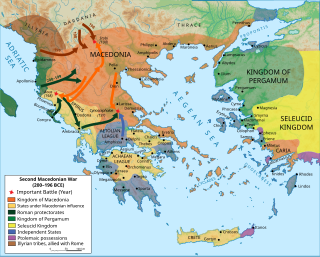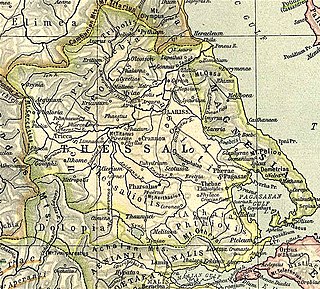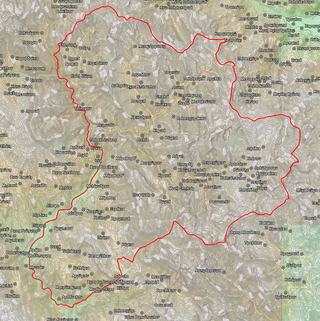Related Research Articles

Philip V was king of the ancient Greek kingdom of Macedon from 221 to 179 BC. Philip's reign was principally marked by the Social War in Greece and a struggle with the emerging power of the Roman Republic. He would lead Macedon against Rome in the First and Second Macedonian Wars. While he lost the latter, Philip later allied with Rome against Antiochus III in the Roman-Seleucid War. He died in 179 BC from illness after efforts to recover the military and economic condition of Macedonia and passed the throne onto his elder son, Perseus of Macedon.

The Second Macedonian War was fought between Macedon, led by Philip V of Macedon, and Rome, allied with Pergamon and Rhodes. Philip was defeated and was forced to abandon all possessions in southern Greece, Thrace and Asia Minor. During their intervention, although the Romans declared the "freedom of the Greeks" against the rule from the Macedonian kingdom, the war marked a significant stage in increasing Roman intervention in the affairs of the eastern Mediterranean, which would eventually lead to Rome's conquest of the entire region.
The Third Macedonian War was a war fought between the Roman Republic and King Perseus of Macedon. In 179 BC, King Philip V of Macedon died and was succeeded by his ambitious son Perseus. He was anti-Roman and stirred anti-Roman feelings around Macedonia. Tensions escalated and Rome declared war on Macedon.

Pherae was a city and polis (city-state) in southeastern Ancient Thessaly. One of the oldest Thessalian cities, it was located in the southeast corner of Pelasgiotis. According to Strabo, it was near Lake Boebeïs 90 stadia from Pagasae, its harbor on the Gulf of Pagasae. The site is in the modern community of Velestino.

The Battle of Callinicus was fought in 171 BC between Macedonia and the Roman Republic near a hill called Callinicus, close to the Roman camp at Tripolis Larisaia, five kilometres north of Larissa, the capital of Thessaly. It was fought during the first year of the Third Macedonian War. The Macedonians were led by their king, Perseus of Macedon, while the Roman force was led by the consul Publius Licinius Crassus. The Macedonians were supported by Cotys IV, the king of the Odrysian kingdom and his forces, Cretan mercenaries, and auxiliaries of mixed nationalities. The Romans had their Italian allies with them and were supported by soldiers provided by Eumenes II of Pergamon, as well as a force of Thessalian cavalry and Greek allies. The battle saw the deployment of troops with cavalry intermixed with light infantry. Although the battle was actually inconclusive because Perseus withdrew before it came to a conclusion, it was considered a Macedonian victory because the Romans suffered heavy casualties.

Pythion or Pythium, also Pythoion (Πύθοιον) was a city and polis (city-state) of Perrhaebia in ancient Thessaly, situated at the foot of Mount Olympus, and forming a Tripolis with the two neighbouring towns of Azorus and Doliche. Pythion derived its name from a temple of Apollo Pythius situated on one of the summits of Olympus, as we learn from an epigram of Xeinagoras, a Greek mathematician, who measured the height of Olympus from these parts. Games were also celebrated here in honour of Apollo.

Doliche was an ancient Greek city and polis (city-state) in Perrhaebia in Thessaly, situated at the foot of Mount Olympus. Doliche, with the two neighbouring towns of Azorus and Pythion (Pythium), formed a Tripolis.

Argithea is a village and a historic municipality in the Karditsa regional unit of Greece. The seat of the municipality is in Anthiro. The name derives from ἀργός + θέα.



Theuma was a town of Ancient Thessaly near the frontiers of Dolopia. Livy relates that the retreat of Philip V of Macedon after the Battle of the Aous allowed the Aetolians to occupy much of Thessaly, and these latter plundered Theuma and nearby Celathara, whereas Acharrae surrendered.
Callithera was a town of Thessaly in the district Thessaliotis, of uncertain site. Livy relates that the retreat of Philip V of Macedon after the Battle of the Aous allowed the Aetolians to occupy much of Thessaly. Whilst they were devastating the fields round Metropolis the townsmen who had mustered in force to defend their walls inflicted a repulse upon them. Then, in an attack upon Callithera they met with similar resistance, but after an obstinate struggle they drove the defenders back within their walls. As there was no hope whatever of their effecting the capture of the place, they had to content themselves with this success. The Aetolians then continued to attack nearby Acharrae, Theuma, and Celathara, the latter two which they plundered.
Cypaera or Kypaira or Cyphara or Cyphaera (Κύφαιρα) was a town and polis (city-state) of Ancient Thessaly, in the southern part of the district Thessaliotis or Phthiotis, near the confines of Dolopia. Livy relates that the retreat of Philip V of Macedon after the Battle of the Aous allowed the Aetolians to occupy much of Thessaly, and these latter, after sacking Xyniae took Cypaera. It has been located at a site called Palaia Yannitsou within the territory between the modern villages of Kaitsa and Makrirrachi (Μακρυρράχη), in the municipal unit of Xyniada.





Meliboea or Meliboia was a town and polis (city-state) of Magnesia in ancient Thessaly, mentioned by Homer, in the Catalogue of Ships in the Iliad, as one of the places subject to Philoctetes. It was situated upon the sea coast, and is described by Livy as situated at the roots of Mount Ossa, and by Strabo as lying in the gulf between Mount Ossa and Mount Pelion.

References
- ↑
 Smith, William, ed. (1854–1857). "Theuma". Dictionary of Greek and Roman Geography . London: John Murray.
Smith, William, ed. (1854–1857). "Theuma". Dictionary of Greek and Roman Geography . London: John Murray. - ↑ Livy. Ab urbe condita Libri [History of Rome]. Vol. 32.13.